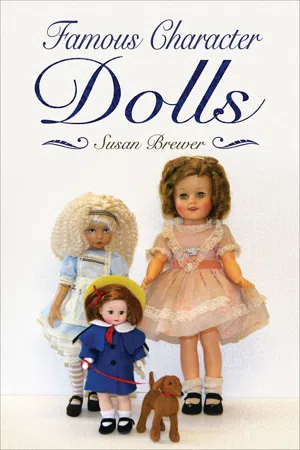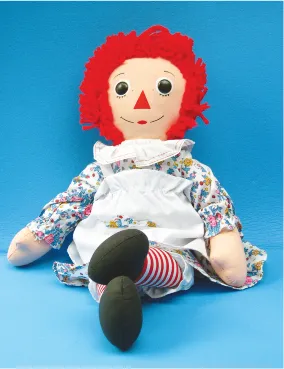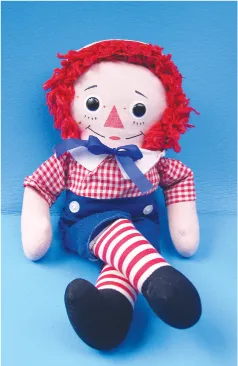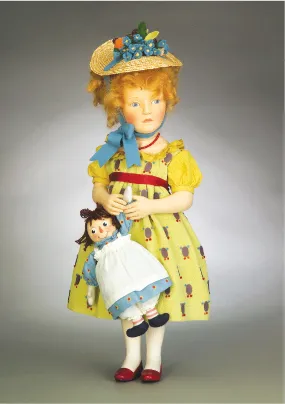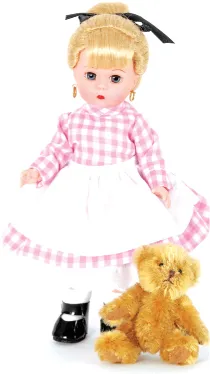![]()
Chapter One
Dolls in Books
DOLLS FEATURE in hundreds of books, especially those for children, yet only a few of the dolls pictured are actually named. They are frequently included in a general capacity, maybe to illustrate a type of doll, or as an adjunct to a story. Often, they are just referred to as ‘doll’ or ‘dolly’, with no specific outstanding qualities and are forgotten as soon as the book is closed. Occasionally though, a book will come along containing a doll-based story that captures the public’s imagination. Probably the most famous example is that of ‘Raggedy Ann’, a rag doll which took America by storm when her stories were first published in 1918, and who is still popular today. Some enthusiasts concentrate solely on Raggedy Ann and build up enormous collections of the dolls and related memorabilia.
The true story of Raggedy Ann’s creation is unclear, but the most commonly accepted version is that she was the main character featured in the stories artist Johnny Gruelle told to his young daughter Marcella. Some people believe Raggedy Ann came about when Marcella one day found an old rag doll which had once belonged to her grandmother, in the loft. She showed it to Johnny who drew a face on the doll and called it Raggedy Ann. From then on, the doll became an important part of Johnny’s stories and was soon joined by other characters, notably ‘Raggedy Andy’ and ‘Beloved Belindy’. Sadly, Marcella was just 13 years old when she died after being given a smallpox vaccination at school without her parent’s consent.
As a tribute to Marcella, her heartbroken father later decided to publish the stories he once told her so that other children could enjoy them. They were an enormous success, and it wasn’t long before Raggedy Ann dolls and the other characters were in production. Over the years they have been made by various companies including P. F. Volland, Exposition Dolls, Playskool, Hasbro, Applause, Knickerbocker and Danbury Mint, and Raggedy Ann is still being made today. Legend has it that the earliest dolls, made by the Gruelles themselves, were given a sugar heart, just as Raggedy Ann was in the storybook, but so far, nobody has proved this to be true. Raggedy Ann has red hair, button eyes, a smiling mouth and a distinctive red triangular nose. Her clothing varies; normally a print dress or a skirt and top, but usually with a white apron. Raggedy Andy looks very similar, but tends to wear blue short trousers, red-checked shirt and red striped socks. The other doll, ‘Beloved Belindy’, is a chubby black doll dressed in a large pinafore, hoop earrings and a scarf tied around her head. Knickerbocker produced a now much sought-after version of her in the mid-1960s, wearing a brightly-coloured outfit consisting of a red top and yellow skirt – both with white spots – a red scarf, white apron and the typical red-and-white striped stockings. An earlier 1940s ‘Beloved Belindy’ doll, by Georgene Novelties, wore a red top and floral skirt.
Interestingly, several manufacturers have also produced versions of ‘Marcella’ dolls, based on the girl who owned Raggedy Ann.The most beautiful is probably the limited edition of 250 created by doll maker R. John Wright which was released in 2005. Wright is a very talented sculptor and his felt creations are deservedly, expensive, but they are stunning and incredibly realistic. His limited edition, well-detailed versions of Christopher Robin, Alice in Wonderland, Flower Fairies, Heidi, Kewpie dolls, Dorothy from the Wizard of Oz, Kate Greenaway children and The Little Prince from the book of the same name, are true collectors’ items. They are designed by John and Susan Wright and produced at the company’s workshop in the New England state of Vermont, America. The felt used is hand painted, and the dolls are sturdy and very beautiful.
Wright’s ‘Marcella and Raggedy Ann’ doll is a 17in-tall, fully jointed doll made from wool felt and with a mohair wig. Marcella’s facial features are hand painted and she is dressed in a cotton gauze dress with a felt appliqué pattern. Her straw hat is trimmed with felt flowers and fruit. She has cream cotton stockings and leather slippers, and holds a felt 6in Raggedy Ann doll. Another impressive doll is a 16in porcelain-headed doll on a hand-carved, spring-jointed wooden body, designed by Wendy Lawton in her Childhood Classics series. Called ‘Marcella and her Raggedy Family’, this beautiful doll with blue eyes and blonde curls, was produced to celebrate the 80th anniversary of Raggedy Ann. Limited to 1,000, Marcella wears an exquisite cream-frilled, lace-trimmed, long-sleeved dress. She holds a 6in Raggedy Ann and a similar size Raggedy Andy. Other Marcella dolls include those by the Madame Alexander Doll Company and Precious Moments. The Madame Alexander version, ‘Marcella Loves Raggedy Ann’, is one of the 8in sweet-faced Wendy dolls, which are the company’s hallmark. Made from vinyl and fully jointed, the doll has blonde hair, blue eyes, and wears a pretty pink coat over a white-skirted outfit. She also has a matching pink hat, white socks, black shoes, and her very own Raggedy Ann doll. The Precious Moments doll ‘Marcella tells the Story of Raggedy Ann’, is a 12in Marcella designed by Linda Rick. It brings a fresh look to the original Precious Moments face first designed by Sam Butcher more than thirty years ago. Precious Moments dolls are classic ‘character face’ types.
In 1915 a particularly interesting doll-themed story book, The Dolls’ Day, by Carine Cadby, was published. It was illustrated with black-and-white photographs of three bisque china dolls. They were shown paddling in a stream, climbing trees and precariously dangling from branches, and it’s surprising that none of them seemed to be damaged at the end of their adventure. Although the dolls in the book never became household ‘famous dolls’, they were given names – ‘Charles’ was the boy, ‘Belinda’ the girl, and the small one was ‘Baby’ (whose sex wasn’t made clear). Of course, these dolls were already in mass production. Usually when a doll is featured in a book, it is one created especially for the story and then later sold to the public, but in the case of The Dolls’ Day, it was the other way round. Presumably the author used dolls she already owned, or maybe she bought them from a toyshop especially to use in the book. Nowadays, the dolls depicted in the book are valuable collectors’ items, and few of today’s collectors would contemplate using their dolls in such a way. In fact, many collectors are horrified when they see the book’s illustrations showing the dolls being treated so casually. Yet when we think about it, it is the equivalent of buying a few modern vinyl dolls and using them as models. We wouldn’t worry if they became damaged because we know they can be easily and cheaply replaced, just as beautiful bisque dolls could be a hundred years ago!
Raggedy Ann, Knickerbocker.
Raggedy Andy, Knickerbocker.
Marcella and Raggedy Ann, R. John Wright.
Edith the Lonely Doll, Madame Alexander.
Author Rumer Godden was fond of writing about dolls, and she used a doll theme for several of her charming children’s books. Her most famous creation is ‘Tottie’, the peg doll who lived in the dolls’ house in her 1947 book The Dolls’ House, along with snooty Marchpane and sweet little Birdie, a celluloid doll which horrifically caught fire. The book was made into a successful television series in 1984, called Tottie, the Story of a Dolls’ House. It was adapted for television by Peter Firmin and Oliver Postgate, creators of such programmes as Bagpuss and Ivor the Engine and was narrated by Postgate. The series achieved some notoriety as being the first children’s programme to include a murder! A second series of five stories, also made by Smallfilms, was entitled Tottie, A Doll’s Wish.
Rumer Godden’s charming books include several others which feature dolls. Amongst them are The Story of Holly and Ivy, The Fairy Doll, Little Plum, Miss Happiness and Miss Flower, and Home is the Sailor. Particularly enchanting is Miss Happiness and Miss Flower, which tells how a shy little girl built an authentic paper house for two Japanese dolls and gained confidence in the process as it necessitated her researching the details and then buying the required materials. The book Little Plum also tells of Japanese dolls, while The Story of Holly and Ivy is a Christmas tale about ‘Holly’, an unsold doll in a toyshop. A cute little rag doll who has plenty of adventures is featured in a trio of books by Modwena Sedgwick. The first in the series was called The Adventures of Galldora, but this little doll actually made her first appearance in 1953 in the BBC’s Children’s Hour. Galldora isn’t a pretty doll, but she is much loved by Marybell. She was made by Uncle Jack who thought up the name after rearranging the letters in ‘a rag doll’.
One of the saddest book dolls must be Edith in the 1957 book The Lonely Doll, the first in a series by Dare Wright. The adventures of this small felt doll were shown in photographs taken by Wright which were accompanied by a brief text. Wright’s original ‘Edith’ was a ‘Lenci’, a type of felt doll created by Elena Scavini in 1920 but which was discontinued before the book was published. Lenci was the nickname given to Scavini by her husband. The Lonely Doll featured Edith wearing a pink gingham frock and white apron. This is the most familiar of the outfits, though she has worn others, and is the outfit in which most manufacturers depict her. The Madame Alexander Doll Company, for example, issued an 8in ‘Wendy-type’ doll in her pink gingham frock and white apron, and with her blonde hair swept back in a pony tail, revealing tiny gold earrings. Her hair sported a black ribbon which matched her shoes, and she came with a jointed 3in Mr Bear.
Edith appeared in other books, including Edith and the Duckling, Edith and Midnight and A Gift from the Lonely Doll – in which Edith goes to stay with Mr Bear’s cousins, taking with her an extra-long muffler she had knitted as a surprise. Edith tries sledging, ice-skating, and also finds time to decorate the Christmas tree. This book was later issued in a special pack, together with a vinyl Edith who is dressed ready for winter in a warm, blue coat, black hat and fluffy black muff. The doll was made by Kids At Heart in the 1980s. Madame Alexander later issued a doll complete with a duckling from the Edith and the Duckling book. Perhaps the most stunning of the Edith dolls are a set of limited editions made by renowned maker R. John Wright in 2007 to commemorate the 50th anniversary of the publication of The Lonely Doll. Wright depicts Edith in her characteristic pink-checked gingham frock.
Another very special ‘book doll’ is ‘Hitty’, a kind of wooden Dutch doll. She starred in Hitty: Her First Hundred Years, written in 1969 by Rachel Field. This unusual book tells of a doll carved from a piece of mountain ash in the early 1800s, for a little girl called Phoebe. The doll’s memorable name, Hitty, is actually short for Mehitable, and she is drawn to perfection in a series of pen-and-ink sketches by Dorothy P. Lathrop. Hitty’s life is full of adventure, and her escapades include becoming lost in India, being left in a church, going to sea and getting sold at auction. Over the decades many dolls have appeared in Hitty’s likeness, including some by the famed American wood-carver Robert Raikes, who issued an open edition of the dolls in 2001. In the United States, various outfits are available to fit Hitty, some of which are ‘sew it yourself’ kits containing the necessary fabric and patterns. Some people also sell ‘Hitty Kits’ consisting of wooden forms which need to be carved and assembled into dolls.
The sweet doll which appears in Pamela Scarry’s My Dolly and Me – one of the American Little Golden Books – was later created as a baby doll figure. Eloise Wilkin’s charming illustrations show a little girl and her unnamed doll as they go for a walk, do some washing, play at cowboys, and take a nap. The girl is drawn dressed like ‘a grown-up mother’ carrying her ‘baby’ and amazing her mummy who enters into the spirit of the game by pretending she doesn’t recognise her daughter. Eloise was responsible for illustrating many books in the Little Golden Books series, one of her most popular being Baby Dear which also features a girl copying her mother by taking care of her dolly. The doll was actually designed by Eloise for the Vogue Doll Company in 1960. Called ‘Baby Dear’, it was a soft-bodied, crumpled-face baby with short hair, and arms with clenched fists. The arms were held upwards, in a very realistic pose. Several versions of this sweet doll were produced over the years, and today she is one of the American classics.
A surreal, rather unnerving family of dolls known as the ‘Mennyms’, appear in a series of books by Sylvia Waugh. The life-sized cloth dolls with blue faces include ‘Sir Magnus’, ‘Tulip’, ‘Joshua’, ‘Vinetta’, ‘Wimpey’, ‘Poopie’, ‘Pilbeam’, ‘Appleby’, ‘Soobie’, ‘Miss Quigley’ and baby ‘Googles’. The stories tell how these human-sized dolls were made by dressmaker Kate Penshaw who brought them to life. They live amongst humans, though have as little contact with them as possible in case their secret should be guessed. Although the books are intended for children, they are quite scary in parts. Nevertheless, the series is compelling, even for adults. The Mennyms try to act like humans, even to the extent of pretending to eat and drink, going shopping, ‘visiting’ each other (by slipping out the back way and coming to the front door) and travelling in disguise in taxis. The books contain plenty of food for thought, indirectly dealing with subjects such as death and immortality.
A book written almost 120 years ago has caused considerable controversy over the last few decades by introducing a character doll which many now feel is demeaning. The 1895 book, The Adventures of Two Dutch Dolls and a Golliwogg, written by Bertha Upton and illustrated by her daughter Florence, introduced the concept of the golly, a black rag doll with a caricature face, based on a doll Florence had been given. Soon gollies were the favourites of thousands of children, a much-loved toy found in every ...
